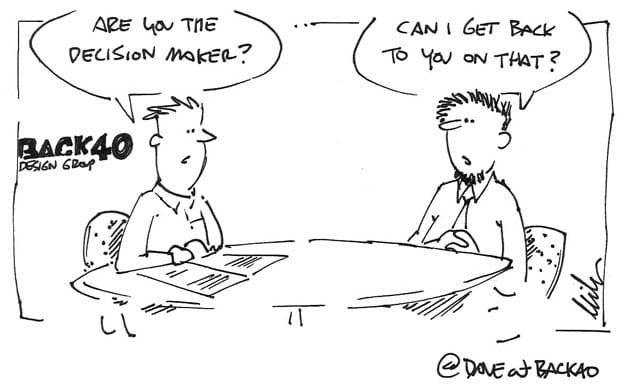When we run into a ‘less than smooth’ working relationship with a client, it’s usually because we blew off one or more of the following guidelines:
1. Will this client benefit from our services?
Is this proposed project a viable project that will benefit your client? That sounds judgmental, but if it’s a wacky web idea – it might be better to pass on the project. I do suggest taking a limited amount of time to discuss the project with the prospect. By sharing your experience, you are benefiting the potential client. At the end of the conversation, you will have given the prospect some useful information – or at the least helped define their project vision. That person will most likely have good things to say to others about their experience. Maybe even recommend your firm to others.
Watch out for this thinking: “We should take on this project even though it’s not right for us because the client would benefit MORE from our services than a competitor’s.” That’s not the issue. The issue is what’s best for the client.
2. Are we meeting with the decision maker?
Is the person you’re presenting to able to give the “go ahead” on this project? It’s not always possible to deal directly with the decisionmmaker, but the more you know about how this type of decision is made and the closer your proximity to the decision maker – the better chance for success. If the situation is unclear, sometimes it’s a matter of asking if the contact is the one making the decision – and then, if they are not, is it possible to meet briefly with the decision maker?

3. Will our firm benefit from working with this client?
The benefits to your company need not be strictly monetary, but for ROI purposes they do need to be defined. You may want to consider the publicity value of working with a high profile client or organization, coding something you can use/sell again, or that ‘smiley face’ (‘warm and fuzzy’?) feeling you get helping a pro bono client in need. Expect the scale to slide dramatically if you simply need to the work to keep the doors open.
4. Does this client have the funds to pay for our services?
If the client is ready to sign on the dotted line, then they should be ready to pay your established engagement fee. Ready to sign, but dropping off the check later? They may not be the ideal client. It’s a judgment call – as long as later actually happens when later is supposed to happen. If chasing around payments becomes part of the process – red flag. Also look out for:
– Ralph the Re-negotiator
– Tammy Trade-for-Services
– Credit Card Denied Denny
– Pay Out Over Time Ted
A little more about payment plans and web design. In my experience paying out web development has not worked well. Years ago, we developed a custom website for a local restaurant. The client was happy and we loved eating lunch there -except for our last visit. They were shut down and so were our payments.
5. Can we work with this client?
This is probably the most subjective of all the questions. Sometimes it’s impossible to tell from the initial meeting and through email if it’s going to work. Here are a few questions that might help define the relationship:
– Are you enjoying the process so far?
– Does the prospect respect meeting times and guidelines?
– Are they timely in their response?
– Have they researched your company?
– Do they reference completed projects?
– Have they been referred by another client?
Strange how it all works out: What’s best for you is best for the client *and* what’s best for the client is best for you.